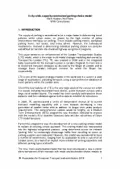-
Past ETC Papers

Browse, search and view papers from the past AET Conferences.
-
Members' Area

AET promotes networking and exchange of ideas, information and opportunities amongst members.
ETC Conference Papers 2010
Glasgow, United Kingdom
ETC Conference Papers 2010
A city-wide, capacity-constrained parking choice model
Seminar
Day 1 (11 Oct 2010), Transport Planning Models and Methods, Car Ownership Modelling, 11:00 - 13:00
Status
Accepted, documents submitted
Authors
M Hudson, N Raha, MVA Consultancy, UK
Short abstract
A parking model has been developed with capacity-constrained choice between parking sites and simultaneous allocation of demand across all purposes and model zones. Constraints are managed via utility modifications passed to the demand model.
Abstract
The London Transportation Studies (LTS) model is the primary multi-modal forecasting tool of Transport for London (TfL). As part of a recent programme of model enhancements carried out on behalf of TfL by MVA Consultancy, Jacobs Consultancy and Mott MacDonald, the existing parking model used within LTS was replaced with a more sophisticated approach. The previous parking model was part of the highway assignment process, using deterrence curves on specific network ?parking links? to discourage traffic from travelling to zones as their parking supply was occupied. However, there were a number of deficiencies with this method, such as: parking supply constraints on demand were not strictly enforced; no distinction was made between different types of parking space (e.g. public, private, workplace) or, therefore, the journey purposes which might use them; no account was taken of parking charges; there was no influence of morning peak parking demand on parking availability in the interpeak; and, only model zones within Central London and some parts of the London Docklands contained parking links.
The new parking model covers all 800+ model zones within the Greater London Authority (GLA), and it now forms a separate module which sits between the distribution/mode split (DMS) model and the assignment models. Each GLA zone is allocated a supply of three parking types: public on-street, public off-street, and private non-residential (workplace). The zonal supplies of these types were derived by applying regression models to parking survey data and travel diary information. Each type of space has an associated parking charge, which may differ by zone, time of day and journey purpose. The parking model runs in the morning peak and interpeak periods, processing synthetic from-home demand for Commuting, Employer?s Business and Other purposes; Home-Based Education and Non-Home-Based trips are not considered. Different journey purposes have different types of parking available, with workplace parking available only to commuting trips. Parking spaces are assumed to be occupied for purpose-specific average durations, leading to an effective supply dependent on the purpose mix of demand to a zone. Parking spaces are assumed to be empty at the start of the morning peak, while supplies in the interpeak are a function of the utilisation in the morning peak.
The main improvements over the previous parking model are in the treatment of parking choice and capacity constraint. Each GLA zone is associated with a group of nearby zones which forms a parking area. Trips to a given zone can utilise the parking supplies in its parking area, thereby making a distinction between the destination zone and the parking zone. The choice of parking zone and parking type is modelled as a multinomial logit that is a function of parking charge together with search time and egress time components. The parking areas of different zones overlap, leading to competition between demand. We simultaneously allocate demand for all journey purposes and all destination zones to their chosen parking locations within a given modelled time period. An iterative procedure is used to redistribute demand from over-utilised parking sites to those which have available capacity, taking account of the relevant parking areas. Average parking costs for each destination zone are calculated for the demand distribution across parking sites, and excess demand which could not be accommodated by the available supply is calculated. From this excess demand we derive ?shadow costs?, which are designed to reduce the utility of travelling to each destination by car so that demand is suppressed just enough to remove the excess and satisfy the supply constraint. The shadow costs and average parking charges are passed from the parking model to the DMS in a loop that is run for a fixed number of iterations. The use of shadow costs in this iterative process has been shown to be effective in reducing demand to zones in which there is insufficient supply to accommodate it.
Currently, the new parking model is designed to modify the cost of car travel used in the demand model for trips to particular destinations by modelling the availability of parking and the charges associated with the supplies. However, the trip matrix passed to the highway assignment model does not make a distinction between a destination zone and a parking zone, and so at present the effect of the parking model on the assignment matrix is applied indirectly through the DMS rather than by directly taking account of rerouting to a parking site. This extension is being considered for a future enhancement phase.
Documents:

Association For
European Transport
Forester House
Doctors Lane
Henley-in-Arden
Warwickshire, UK
B95 5AW
+44 (0) 15 64 793552
VAT number: 710 1866 64
Conference Supporters & Endorsers




Legal Entity
The Association for European Transport is registered as an Association ('vereniging') with the Chamber of Commerce for Haaglanden in The Netherlands under company number 27170096.
Built on Zenario




